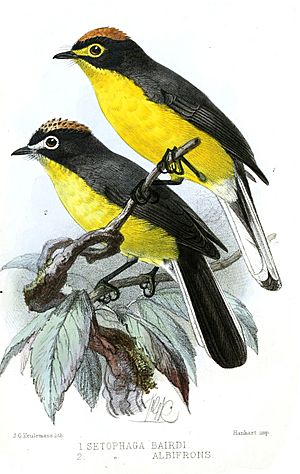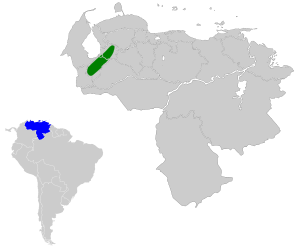White-fronted whitestart facts for kids
Quick facts for kids White-fronted whitestart |
|
|---|---|
 |
|
| Lower bird with Myioborus melanocephalus (above) | |
| Conservation status | |
| Scientific classification | |
| Genus: |
Myioborus
|
| Species: |
albifrons
|
 |
|
The white-fronted whitestart (Myioborus albifrons) is a small, colorful bird found only in the mountains of western Venezuela. It's known for its bright feathers and active nature. This bird is a type of New World warbler and is special because it lives only in a specific area, making it endemic to the Andes mountains there. Sadly, its home is shrinking, which means it's a species that needs our attention.
Contents
What is a White-fronted Whitestart?
The white-fronted whitestart is a beautiful bird. It belongs to the Parulidae family, which includes many types of New World warblers. These birds are often small and very active. They are known for their bright colors and cheerful songs.
Appearance of the Whitestart
This bird gets its name from the white patch on its forehead. It also has other bright colors, like yellow on its belly and chest. Its back and wings are usually a darker color, helping it blend into the forest. These colors help it attract mates and warn other birds.
How Big Are They?
White-fronted whitestarts are small birds. They are about the size of a sparrow. Their small size helps them move quickly through the dense forest. This makes them hard to spot sometimes.
Where Does the White-fronted Whitestart Live?
This special bird lives only in the Andes mountains. Specifically, you can find it in the western part of Venezuela. It prefers certain types of places to live.
Forest and Woodland Homes
White-fronted whitestarts live in forests and woodlands. They like areas with lots of trees and plants. These habitats provide them with food, shelter, and safe places to build nests. They often stay in the middle and upper parts of trees.
Endemic to Venezuela
When a species is "endemic," it means it lives only in one specific place in the world. The white-fronted whitestart is endemic to the Venezuelan Andes. This makes it very unique and important to protect. If its habitat in Venezuela disappears, the bird could disappear forever.
Why is the White-fronted Whitestart in Danger?
Even though these birds are beautiful, they face big problems. The main threat to their survival is the loss of their home. This is called habitat loss.
What is Habitat Loss?
Habitat loss happens when natural places are destroyed. This can be because of farming, building new towns, or cutting down trees for wood. When forests are cut down, the birds lose their homes. They also lose their food sources and places to raise their young.
Impact on the Birds
When their habitat shrinks, white-fronted whitestarts have less space to live. They might struggle to find enough food. It also becomes harder for them to find mates. This can lead to fewer baby birds being born. Over time, the number of these birds goes down.
How Can We Help Protect Them?
Protecting the white-fronted whitestart is important. There are ways people can help save these birds and their homes.
Protecting Forests
One key way to help is to protect the forests where they live. This means stopping deforestation. It also means creating protected areas. These are places where trees cannot be cut down.
Supporting Conservation
Many groups work to save endangered animals. Supporting these groups can make a difference. They help educate people about wildlife. They also work with local communities to find ways to live with nature.
Being Mindful of Our Choices
Even small actions can help. Choosing products that are made in a way that doesn't harm forests is one example. Learning more about these birds and sharing what you know also helps. Every effort to protect nature counts.
See also
 In Spanish: Candelita frentiblanca para niños
In Spanish: Candelita frentiblanca para niños


